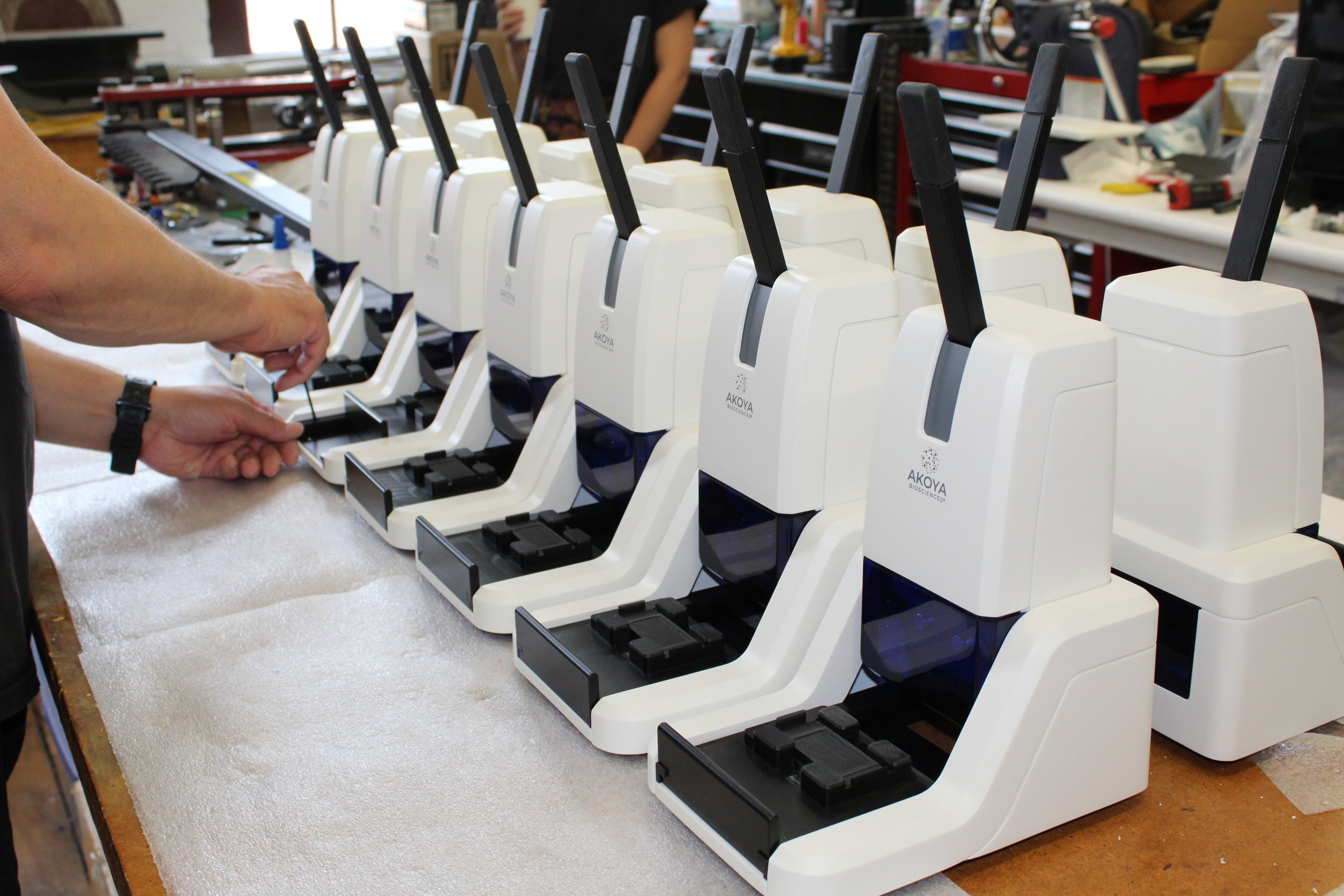INDUSTRIAL DESIGN - MECHANICAL ENGINEERING - PROTOTYPES - LOW VOLUME PRODUCTION
The Flow Cell Assembly Device (FCAD) is a new way of creating a flow cell for tissue analysis on the PhenoCycler®-Fusion System, Akoya Biosciences’ revolutionary biomarker imaging technology which enables researchers to study how cells organize and interact to influence disease progression and response to therapy. The FCAD creates a consistent, repeatable, and accurate method to create quality flow cells made from glass slides, tissue samples and adhesive.
The FCAD allows for a flow cell which is a closed system where the slide assembly is made inside the device, protected from contaminants and user error. Each slide is consistent and of high quality because of the intuitive operating procedure and each step is designed to be done only one way, in one sequence.
Histologists install a slide assembly in the drawer’s registration features.
The lever is pressed down all the way until it stops and stays at the bottom. After at least 10 seconds, the lever is raised and the drawer is pulled out to remove the completed flow cell. A moving guard tracks with the lever to prevent pinch points. Each process step can only be done in one way and in one sequence.
The drawer is pushed all the way forward until it stops. The blue window allows visualization of the slide.
The rear window provides light to the front area and enables viewing of the process. For servicing, the top cover is removed with a fingernail detail. All fasteners are hidden.
CHALLENGE
Stream PD collaborated with Akoya Biosciences’ internal engineering team to create the FCAD product. A functional mechanical prototype existed; the first key challenges for Stream PD were ensuring the device was easy to use, creating a form that visually fit with their established brand and refining it for cost effective manufacturing. Stream PD provided industrial design, mechanical engineering and prototype development to accomplish that goal. The second key challenge was for Stream PD to produce the device- sourcing all internal and external fabricated components and hardware, qualifying all vendors, assembling each device, testing to ensure performance and final shipping.
Form elements such as the soft curves and rugged chamfer feel like the other products in the PhenoCycler-Fusion System, but FCAF uses these elements in a unique way to maintain its own identity.
Final design rendering.
RESULTS
Users of all abilities are able to create a quality flow cell due to the design features of the FCAD, which increases user productivity and confidence. These features include the simple intuitive steps of installing a glass slide in the drawer, pushing in the drawer and pulling down the lever. Each step can only be done one way because of keyed features that prevent incorrect use. Pivot points and levers allow a very light touch to deliver uniform calibrated pressure to the slide, maximizing even engagement on the adhesive. The user touch points of the drawer and handle are both black so you know to interact with them and the handle is soft rubber encouraging you to grip it. The ergonomic design prevents potential hazards by blocking pinch points around the lever with a plastic shield. Ambidextrous use is possible and encouraged. The device is easy to wipe clean since there are smooth forms and no exposed fasteners. The user can also clean the pads through holes in the baseplate and drawer.
The form describes its function, which teaches you how to use the device. The curved housing describes the movement of the handle as the user presses down to create a slide sample. The side arms contain the slides for the drawer and also stabilize the device. The lever and drawer handle are both the same black color because they are the user’s touch points of interacting with the device. The handle has a soft rubber grip for comfortable actuation. The colors of light grey, black and translucent blue make the FCAD fit with PhenoCycler-Fusion System product brand. Form elements such as the soft curve and rugged chamfer feel like the other products in the PhenoCycler-Fusion System, but FCAD uses these elements in a unique way to maintain its own identity. Large translucent blue windows allow the user to visualize the slide as it is being pressed. All materials are able to be wiped down with industry standard cleaners. Smooth soft shapes are easy to wipe down, and there are no exposed fasteners to accumulate potential particulate.
After we completed the development of the device, Akoya engaged us to produce the FCAD. Stream PD sourced all internal mechanism and external fabricated components and hardware, qualified all vendors, troubleshot all production part fabrication issues, assembled each device and made modifications when necessary. We tested each one to ensure performance and shipped the final boxed units to the distribution warehouse.
Procurement and assembly of all mechanical internal components.
Housings are assembled onto internal components, part modifications made as necessary.
Load cell testing to applicable standards to ensure each unit is applying the correct amount of even pressure.
We oversaw the design, production and drop testing of the foam insert and cardboard container. The finished and tested product is boxed, labelled, wrapped and shipped out from Stream PD.
















